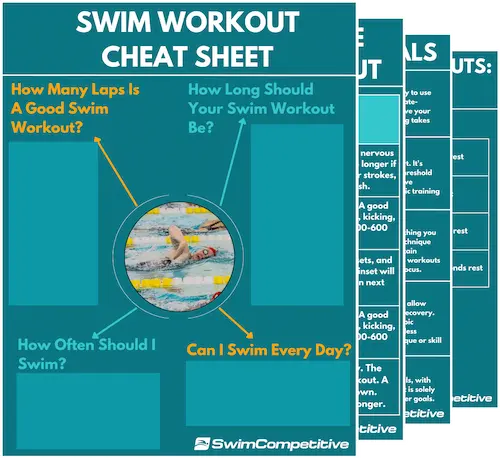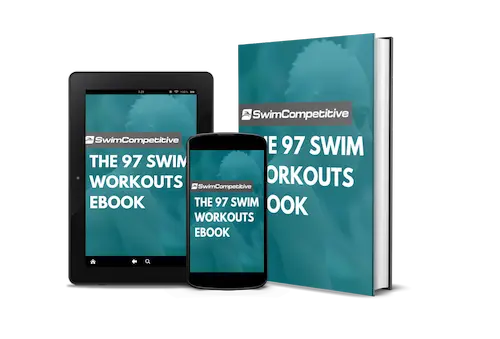As swimmers, we are always training to get faster in the water. We do this by mostly swimming, but there comes a point where getting stronger outside of the water is just as important as getting stronger inside of the water.
Swimming is a sport where almost every single muscle in your body is used. Weight training and other dryland training can be hugely beneficial to any swimmer. Whether they are an advanced athlete or just getting started.
However, it can also be quite confusing and a waste of time if you don’t have a properly designed program to make sure you are actually getting stronger.
Many swimmers and other athletes don’t really have an idea of where to start when it comes to weight lifting. As a result, creating a weight training program can be hugely confusing. In this post, we will be covering everything you need to know about weight training and creating a program.
Planning the Basics
Before you can start creating your training program you need to decide on a few things like the number of weeks, the workout splits and the exercises you are going to use. So grab a pen and a piece of paper or open a notepad, because you are going to need to write a few things down before we can begin.
You also need to decide whether you want to just focus on strength or also put some emphasis on building some muscle, we will cover this in the Sets and Reps section down below.
How Long Should the Program Be?
This is the first thing you are going to need to decide, the program can’t be too long, neither can it be too short. I’d recommend making it about 8-12 weeks.
Why? Because you need to give yourself enough time to actually get stronger and progress on the program.
This is also an optimal length for you to see some good results and if it was much longer than 8-12 weeks you would start getting bored of that specific program. After that 8-12 weeks, you will have a deload week where you will decrease workouts, volume and rest a bit before starting a new program.
Yes, you are going to have to keep training if you want to keep your progress and keep seeing results in the water. This is just a part of the sport.
Workout Splits
a Workout split basically refers to how you are going to structure your program and what body parts you are going to train on specific days. There are only 2 types of splits that I recommend, you can choose whichever one you think is going to be the best for you.
Full Body Split
This is the most basic split, it refers to training your entire body about 3 times a week with 1-day rest in between. Here is a basic example-
- Monday- Full Body Workout.
- Tuesday- Rest.
- Wednesday- Full Body Workout.
- Thursday- Rest.
- Friday- Full Body Workout.
- Saturday- Rest.
- Sunday- Rest.
That is a basic example you can structure it any way you like as long as there is at least 1-day rest in between. I’d recommend this to most people, especially if you are brand new to weight training.
This split has more frequency than other splits because you are training each body part 3 times a week instead of 2 times. This is great for beginners since it will stimulate your muscles more frequently and thus you can get stronger quicker.
a Downside to this split, however, is that you are going to have to train each body part in a single workout, this can make workouts extremely long and limit the number of exercises you can perform for each body part.
If you do decide to choose this split I’d recommend putting emphasis on your core exercises to make sure you are getting enough core training, check out my article on core exercises here.
Upper/ Lower Split
This is the second split I’d recommend, it’s meant for slightly more advanced trainees or swimmers who have some experience with dry land. However, if you are a complete beginner and this split suits you better it will be just fine for you too.
The split refers to training 4 times a week splitting the workouts up into 2 upper body workouts and 2 lower body workouts. Here is a basic example-
- Monday- Upper Body Workout.
- Tuesday- Lower Body Workout.
- Wednesday- Rest.
- Thursday- Upper Body Workout.
- Friday- Lower Body Workout.
- Saturday- Rest.
- Sunday- Rest.
You can structure this split whichever way it fits you, as long as you keep the basic structure from the example. This split is better in terms of time friendliness per workout since you have more training days to fit everything into.
The frequency is slightly less than the full body split, but generally, it’s not a problem. This is a great split and my personal favorite.
Exercise Selection
Now that you have decided which split you want to use it’s time to decide what exercises you are going to include in your program. Below I have put together a full list of exercises that are beneficial to strength and more specifically to swimmers.
Make sure to select 2-3 exercises for each major muscle group.
Keep in mind if you are doing the full body split, you shouldn’t select more than 2 per muscle group. Also, keep in mind not all of the exercises have to be weight orientated, it’s important to include some bodyweight exercises as well.
Legs (Important)
- Low Bar Back Squat
- Front Squat
- Lunges
- Calve Raises
Core (Try to choose at least 3-4 exercises).
- Planking
- Flutter Kicks
- Hanging Knee-Raises
- Sit-Ups
- Crunches
Back
- Pull-ups
- Rows
- Deadlifts
Chest
- Bench Press
- Dips
- Push-ups/ Press- Ups
- Flies (dumbbell flies, cable flies, resistance band flies)
Shoulders
- Overhead Press
- Most exercises will cover shoulders don’t stress it too much.
Triceps
- Skull Crushers
- Cable/ Resistance band pulldowns
Biceps (optional)
- Chin Ups
- Curls
Check out my article on dryland exercises for swimmers for a complete breakdown of over 150 of my favorite exercises.
Do You Want to Make Every Lap Count?
Stop wasting your time in the pool feeling lost and doing directionless swim workouts, and start training effectively! Our ebook contains 97 structured and goal-orientated swim workouts to help you become a better, faster, and fitter swimmer. Whether you’re a complete beginner or a seasoned pro, there are a multitude of workouts for every type of swimmer.
Sets and Reps
When creating your program you have to decide how many sets and reps you want to do on your exercises, it can be different for each exercise.
Earlier we also discussed whether you want to just focus on strength training or also put some emphasis on building muscle mass.
Keep in mind you will build muscle mass regardless if you are getting stronger, this is just if you want to speed that process up a bit.
Sets
- I recommend doing 3-4 sets if you want to focus on building muscle.
- I recommend 5-6 sets if you want to focus on strength.
Reps
- I recommend 10-15 reps if you want to focus on building muscle. (lower weight, higher reps)
- I recommend 5-6 reps if you want to focus on building strength. (higher weight, lower reps)
You can mix it up and focus on strength with compound exercises like the squat, deadlift, and bench press and on building muscle with smaller exercises like dips, curls, and calve raises.
Progressive Overloading
The term progressive overload refers to progressively increasing the difficulty of the exercises in order to get stronger. This is probably one of the most important aspects of any workout program.
If you don’t progressively overload, you won’t get stronger and all of your time and effort would be a complete waste of time. Since you would be staying in the same place and plateauing.
Luckily for you, this isn’t hard to incorporate into your training. Here are a few ways to progressively overload each week or workout-
- Add more weight to the bar. (Most basic way and most effective way)
- Increase the number of reps.
- Increase the number of sets.
- Add weight to exercises that don’t use them.
- Increase the number of seconds for certain exercises like the plank.
When creating the program apply these principles to your different exercises each week or each workout in order to get stronger.
Creating the Program
Now that you have decided on all of the different aspects in creating your weight lifting program you can put together your program. Make sure to progressively overload since this is extremely important if you want to get stronger.
How to create my program?
- Get a pen and paper or a notepad on your phone or computer out.
- Write down each of the different weeks.
- Then Write down each of the different workouts under each week.
- After that Write down the exercises under each workout.
- Add the number of sets and reps next to each exercise.
- Make sure to increase weight, reps, or sets each week or workout in order to get stronger.
Proper Technique and Injury Prevention
It is very important when lifting weights or performing any type of exercise to focus on good technique, this will prevent unnecessary injuries. You can search for the correct technique of certain exercises on Youtube if needed.
In the case that you do get injured don’t stress it too much, monitor it properly and if needed go see a sports doctor of some sort. Make sure to always warm up properly before working out and rather do dynamic stretches instead of static stretches before training.
Nutrition
In order for you to build muscle and get stronger properly, you need to make sure you are consuming enough calories. an Easy way to do this is by eating what you would on a normal day and making it a bit more in order to get more required energy from the food.
If you want to you can track calorie consumption in apps like myfitnesspal, but it’s not necessary. Make sure to eat enough protein and focus on eating healthier food sources. You can use whey protein for extra protein and calories if you want too.
If you have good nutrition it will help you a great deal in getting stronger and building muscle.
Points to Consider When Creating Your Swimming Weight Lifting Program
When creating your program-
- You should decide what your main focus is- strength or muscle mass
- Decide how long you want your program to be. I recommend between 8-12 weeks.
- Choose your workout split- Full body or Upper/Lower Split
- Then decide what exercises you want to include. Feel free to add your own.
- After that decide on your sets and reps.
- Decide what progressive overload you are going to apply throughout your program.
- Finally, create your program
- Remember to focus on technique and warm up properly. Nutrition is in many cases just as important as your training self, make sure to eat enough.





